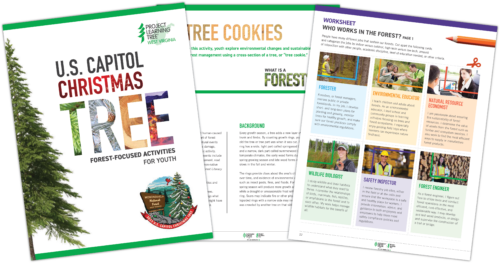December 8, 2023
As the holiday season is in full swing, people around the world partake in the time-honored tradition of searching for the perfect Christmas tree. Whether finding one at a tree farm or getting a permit to cut one down in a national forest, it’s a fun way to spend a crisp winter day. But did you know just what it takes to find one of the most famous Christmas trees each year?
The “People’s Tree,” a 63-foot-tall Norway spruce, arrived in Washington, DC, in late November to grace the Capitol West Lawn thanks to dozens of people who work in forestry and other green jobs.
Getting the 39-year-old, 8,000-pound tree to the Capitol involved a 1,000-mile expedition from West Virginia. There were also close to 60 regular-sized Christmas trees for other locations and offices on the Capitol and more than 14,000 handmade ornaments along for the ride.
View this post on Instagram
Every year, a national forest provides a tree to light up the West Lawn of the US Capitol building for the holidays. West Virginia’s Monongahela National Forest, in partnership with nonprofit partner, Choose Outdoors, transported the 2023 US Capitol Christmas Tree from West Virginia to Washington, DC, with support from sponsors, including the Society of American Foresters (SAF).
Green jobs key to delivering holiday magic
“This wonderful holiday tradition would not be possible without all the people who work in green jobs. We were so pleased to see SAF talk about working in forestry and other green jobs as part of their US Capitol Christmas Tree Forestry FAQs,” said Linda Carnell, Assistant State Forester, Education and Communication, West Virginia Division of Forestry.
The SAF FAQ described how green jobs offer a wide variety of career opportunities based on interest areas and skill sets. Green jobs include positions like foresters, park rangers, wildland firefighters, wildlife biologists, policymakers, public outreach professionals, recreation managers, loggers, and lumber mill workers. Jobs can be seasonal or full-time in both indoor and outdoor settings.
“We were also really pleased to see SAF reference Project Learning Tree’s Exploring Forest Careers. The Green Jobs: Exploring Forest Careers guide includes four hands-on, instructional activities to help youth research forestry jobs and practice managing and monitoring forest resources,” said Carnell, who also serves as the West Virginia Project Learning Tree (PLT) State Coordinator.
The growth of “green jobs”—defined by the Bureau of Labor Statistics as jobs that produce goods or services that benefit the environment or conserve natural resources, or jobs that use more environmentally friendly processes or fewer natural resources—have outpaced jobs in other employment categories by almost 250% over the last decade.
Coming together across West Virginia to celebrate the People’s Tree
 The USDA Forest Service took the People’s Tree on a two-week tour across West Virginia, so that residents of the state could give the tree a proper send-off and also learn about green jobs.
The USDA Forest Service took the People’s Tree on a two-week tour across West Virginia, so that residents of the state could give the tree a proper send-off and also learn about green jobs.
“We were so excited to work with so many different entities to make this happen—towns, cities, communities, schools, 4H clubs. Connecting with so many people, especially kids, about green careers was fantastic,” said Carnell. “Kids respond well when they understand what green jobs are all about. We tell them ‘Yes, you can be in hi-tech and use a satellite and a computer to do your job while you work in the woods’.”
PLT West Virginia created a special U.S. Capitol Christmas Tree activity collection to do with youth around the state. It featured several activities found in the Explore Your Environment: K-8 Activity Guide, including Tree Cookies, Every Tree for Itself, and Our Federal Forests.
Tools, info, and activities to learn about green jobs
Did you know PLT activities also include details about different green jobs? It’s our goal to introduce students to the green job possibilities out there, and we’d love your support in doing so!
Check out some of the green jobs resources that people learned about during the tree’s trip across West Virginia. Explore green jobs that support forests and learn more about career readiness supports through PLT. You can also take a one-time free trial of the PLT Green Jobs Quiz. PLT and SAF are also pleased to announce an online short course – Teaching Youth and Communities About Forests – to help you strengthen your outreach and education efforts to youth and adults. Register Now!
For additional inspiration, get a copy of Black Faces in Green Spaces: The Journeys of Black Professionals in Green Careers.
A holiday tradition dating back to 1964
Massachusetts Senator John McCormack planted a 24-foot-tall Douglas fir on Capitol grounds in 1964. This was the first tree that started the ritual tree lighting on the West Lawn. Sadly, the tree died after three years from wind and root damage.
Today, Jim Kaufmann, Director of the Capitol Grounds for the Architect of the Capitol, chooses the People’s Tree. The USDA Forest Service assesses the environmental impact of harvesting the tree by investigating if the tree is close to any endangered species or water sources and if it provides shelter for wildlife.
In 1970, the Monongahela National Forest supplied the first People’s Tree. In 2024, the Capitol Christmas Tree will come from Alaska.


